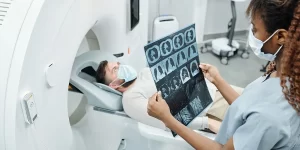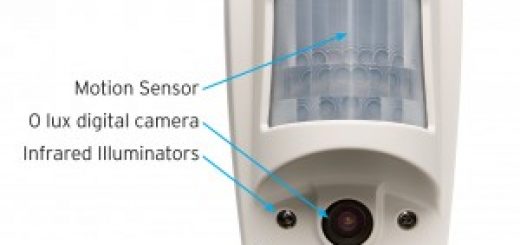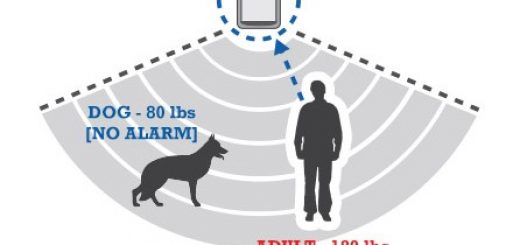Magnetic Resonance Imaging (MRI) uses, advantages and disadvantages
The MRI scan uses magnetism, radio waves, and the computer to produce images of body structures, the benefit of MRI is that, unlike conventional x-ray or CT imaging, it does not use x-ray radiation. Magnetic resonance imaging is the preferred method for imaging soft tissue because it can produce a clearer, more detailed view of internal organs than computed tomography (CT) without the radiation exposure associated with CT.
Magnetic Resonance Imaging (MRI)
MRI is a non-invasive way to view organs, tissues, bones, and other structures inside the body, It uses strong magnetic fields and radio waves to produce internal images of the body, Unlike X-ray and CT scans, MRI machines produce cross-sectional, 3D images of the body without using the use of radiation.
Doctors can use MRI to view parts of the body that are hard to see with other imaging techniques such as x-rays, ultrasound, or computed tomography (CT) scans. MRI scan is used to diagnose many different types of diseases including heart and vascular disease, stroke, muscle and skeletal (bone) disorders, and cancer.
MRI Instruments
The MRI machine is a large, cylinder-shaped machine that contains a very strong donut-shaped magnet, The patient lies on the bed that moves in and out of the machine during the process, The MRI machine is connected to the computer that receives signals from the MRI unit, The computer interprets the signals and generates the 3-D image of the patient’s body.
Magnetic Resonance Imaging, unlike X-rays and CT scans, does not use ionizing radiation, Instead, it uses radio waves that interact with specific molecules in the body (protons, the nuclei of hydrogen atoms), During the test, radio signals are repeatedly turned on and off.
Preparation & Precautions for MRI
The MRI machine is a strong magnet, so patients must avoid wearing jewelry and other accessories because they could interfere with the machine’s magnetic field. Jewelry, watches, credit cards, and hearing aids (all can be damaged) are not allowed to enter the test room, Pins, hairpins, metal zippers, and similar metallic items (can alter images taken) are not allowed to enter the test room, Removable dental work, Pens, pocketknives, eyeglasses are not allowed to enter the test room.
All metallic objects on the body are removed prior to obtaining an MRI scan, patients will be given a sedative medication to decrease anxiety and relax the patient during the MRI scan. Patients with claustrophobia or anxiety may want to request a mild sedative from their physicians.
If the MRI scan will involve a contrasting agent, the patient should tell the physician about any allergies including hay fever, hives, allergic asthma, or food and drug allergies, Radiologist should be informed if the patient has serious health problems such as kidney disease or sickle cell anemia.
During an MRI test, the patient is placed on a table that rolls into the MRI unit, the radiologist and technologist will leave the MRI room and observe from an adjoining room. the physician may decide to use a contrast agent known as gadolinium DTPA to help enhance the image quality of the MRI scan, This non-radioactive contrast agent improves the strength and clarity of the images by emphasizing the tumor-like qualities of any suspicious masses, Ask your doctor about the side effects of the gadolinium-based contrast material if you have kidney problems.
If the contrasting agent is used, an intravenous (IV) line will be inserted into the patient’s hand or arm, which will allow the radiologist to inject the contrasting substance directly into the patient’s body at the appropriate time, The contrasting agent often creates a cooling sensation at the site of injection and throughout the body, The patient may experience some discomfort at the injection site.
The MRI test process
During the MRI scan, the patient will hear loud noises that are generated within the MRI unit while images are being produced, The patient can ask for earplugs to reduce the sound of the MRI scanner, Some of the newer scanners have music to help the patient pass the time, They may be air-conditioned and have lights inside.
When a contrast agent is not used an MRI can show: The shape, size, appearance, and location of organs, bones, and joints, The presence of abnormal growths, and Signs of inflammation or infection, When a contrast agent is used, MRI can show: size and location of benign or malignant growths, enlarged lymph nodes, changes in blood flow, and extracellular volume.
Advantages of MRI
Magnetic Resonance Imaging is non-invasive and does not use radiation, so it can be safely used on people who might be vulnerable to the effects of radiation, such as pregnant women & babies, MRI contrasting agent is less likely to produce an allergic reaction that may occur when iodine-based substances are used for x-rays and CT scans, Magnetic Resonance Imaging offers extremely clear, detailed images of soft-tissue structures that other imaging techniques cannot achieve.
Magnetic Resonance Imaging can easily create hundreds of images from almost any direction and in any orientation, Unlike techniques that examine small parts of the body (i.e. ultrasound or mammography), MRI tests can cover large portions of the body, Magnetic Resonance Imaging can determine if cancer has spread, and help determine the best treatment.
Magnetic Resonance Imaging is useful for scanning and detecting abnormalities in soft tissue structures in the body such as the cartilage tissues and soft organs like the brain or the heart. MRI scans can offer information about blood circulation throughout the body and blood vessels and also enable the detection of problems related to blood circulation.
Disadvantages of MRI
Magnetic Resonance Imaging is expensive ($1000-$1500), It will not be able to find all cancers (i.e. breast cancers indicated by microcalcifications), Magnetic Resonance Imaging can’t distinguish between malignant tumors or benign diseases (such as breast fibroadenomas), which could lead to false positive results. MRI is done in an enclosed space and the loud noises made by the magnets can make some people feel fearful of being on a closely enclosed surface while they have the MRI scan.
Magnetic Resonance Imaging is not painful, but the patient must remain still in an enclosed machine, which may be a problem for claustrophobic patients, An undetected metal implant in a patient’s body may be affected by the strong magnet of the MRI unit, the patient may develop an allergic reaction to the contrasting agent, or that the skin infection could develop at the site of injection, If the patient chooses to be sedated for the scanning, there is a slight risk associated with using the sedation medication.
You can download Science online application on Google Play from this link: Science Online Apps on Google Play
What is PET/CT, Positron emission tomography scan (PET) uses, risks and importance
Computed Tomography (CT) types, uses, advantages & disadvantages
Cone beam CT vs. Fan beam CT, CBCT advantages, disadvantages & uses
Interventional radiology types, Robotic endovascular systems advantages & disadvantages
Artificial intelligence in radiology decision support systems, Medical Imaging & Healthcare
Artificial intelligence in medical field advantages & how AI medical diagnosis changes medicine




